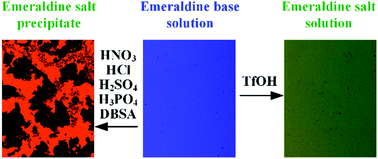Superacid-doped polyaniline as a soluble polymeric active electrolyte for supercapacitors†
Abstract
Using polyaniline as a soluble electrochemically active additive in an electrolyte has the advantages of high pseudocapacitance and good cycle stability of polyaniline, however, the challenge is how to make polyaniline soluble in the electrolyte. In this study, we prepare a solution of polyaniline in N-methylpyrrolidone by protonating polyaniline with trifluoromethyl sulfonic acid. Spectroscopic and electrochemical results indicate that the weak binding interaction, between trifloromethyl sulfonate ions and protonated polyaniline chains, increases the solubility of trifloromethyl sulfonic acid doped polyaniline. An active electrolyte system composed of 15 mg mL−1 polyaniline and 0.4 M trifluoromethyl sulfonic acid in N-methylpyrrolidone is developed. With the active electrolyte and reduced graphene oxide as the electrodes, the fabricated supercapacitor shows a higher specific capacitance than the corresponding electric double-layer supercapacitors. Because the volume change and hydrolyzation of polyaniline, which are the main causes of the performance degradation in polyaniline-based supercapacitors, are avoided, the present supercapacitor exhibits an excellent cycle stability of 100% capacitance retention after 10 000 cycles. This work demonstrates the possibility of directly using a conductive polymer as an active electrolyte in supercapacitors with high cycle stability.



 Please wait while we load your content...
Please wait while we load your content...